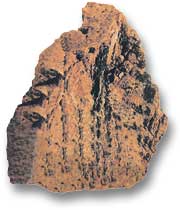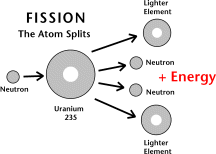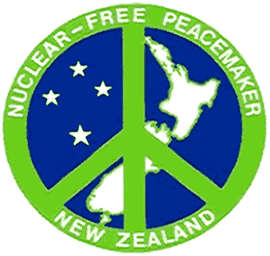

The fuel most widely used by nuclear plants for nuclear fission is uranium. Uranium is nonrenewable, though it is a common metal found in rocks all over the world.


Nuclear energy is energy in the nucleus (core) of an atom. Atoms are tiny particles that make up every object in the universe. There is enormous energy in the bonds that hold atoms together.
Nuclear energy can be used to make electricity. But first the energy must be released. It can be released from atoms in two ways: nuclear fusion and nuclear fission. During nuclear fission, a small particle called a neutron hits the uranium atom and it splits, releasing a great amount of energy as heat and radiation. More neutrons are also released. These neutrons go on to bombard other uranium atoms, and the process repeats itself over and over again. This is called a chain reaction.

Most power plants burn fuel to make electricity, but not nuclear power plants. Instead, nuclear plants use the heat given off during fission as fuel. Fission takes place inside the reactor of a nuclear power plant. At the center of the reactor is the core, which contains the uranium fuel.
Fission generates heat in a reactor just as coal generates heat in a boiler. The heat is used to boil water into steam. The steam turns huge turbine blades. As they turn, they drive generators that make electricity. Afterward, the steam is changed back into water and cooled in a separate structure at the power plant called a cooling tower. The water can be used again and again.

We do not have any nuclear power stations in New Zealand, because the people of New Zealand have said they want to be nuclear free.

ADVANTAGES
Nuclear energy does not pour carbon dioxide into the atmosphere, and so it does not add to global warming. It also produces huge amounts of energy from small amounts of fuel. It is a reliable source of power, and costs about the same as coal.
DISADVANTAGES
Nuclear power has hidden costs, because in the process of making the power, you are left with nuclear waste. This waste is very dangerous because it could kill all life, and it stays that dangerous for thousands and thousands of years. That makes it very dangerous to dispose of safely. Often it is buried deep underground, or under water. The problem comes when the sealed containers spring a leak, which has happened in the past.
If there is an accident at a nuclear power plant, like there was in Chernobyl, many people would be killed, and by making the area around the plant radio-active, no-one could ever live there again.
Nuclear energy uses materials that are also used for making nuclear weapons, and so you have to be very sure you can protect the power plant, and stop nuclear materials falling into the hands of criminals or terrorists, or countries that want nuclear weapons.
Nuclear energy uses uranium, which is a non-renewable resource, so it is not a sustainable source of energy.